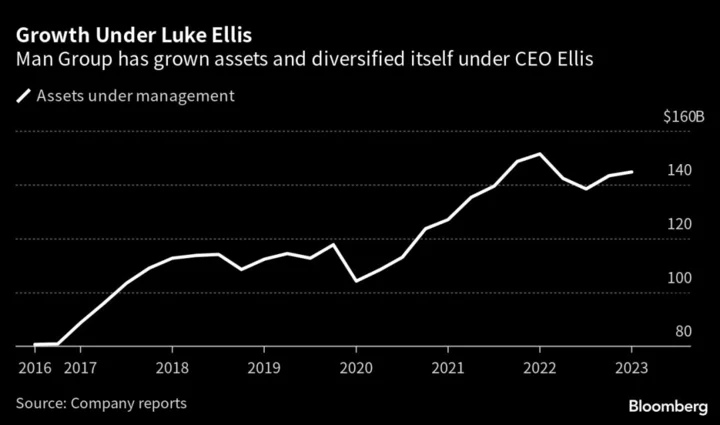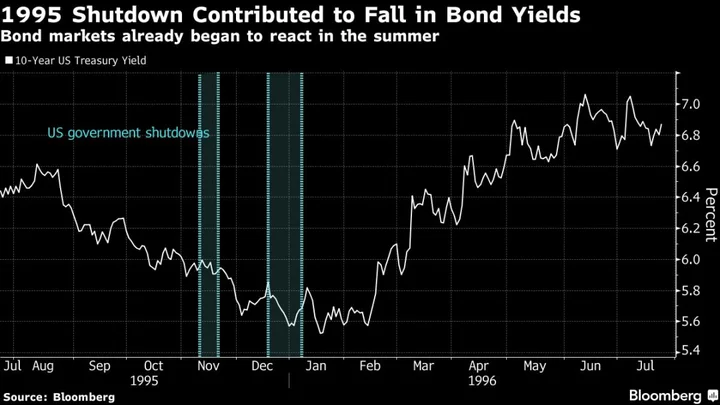When it comes to the US Federal Reserve’s campaign to crush inflation by raising interest rates, Morgan Stanley’s Chief US Economist Ellen Zentner says this: “I have a strong view that they’re done here — but they have left the door open.”
Zentner joined the What Goes Up podcast to discuss the Fed’s decision this week to leave the benchmark federal funds rate unchanged, and what she expects of monetary policy and the US economy going forward. With inflation cooling, the central bank will likely keep rates on hold until it’s ready to cut next year, she says. In the near term, a potential government shutdown by Republicans could leave policymakers without all of the economic data they need to make a decision, bolstering the case for Fed officials to maintain the status quo at the November meeting, Zentner said.
Here are some highlights of the conversation, which have been condensed and edited for clarity. Click here to listen to the full podcast, or subscribe on Apple Podcasts or wherever you listen.
Listen to What Goes Up on Apple Podcasts
Listen to What Goes Up on Spotify
Q: We have a looming government shutdown. Walk us through exactly how you’re thinking about it.
A: In monetary policy making, uncertainty tends to lead to policy paralysis. And so certainly when you have a government shutdown, the breadth of it matters. If it’s a partial shutdown, there are some agencies that will continue to operate and we can continue to get things like payroll data, even if we don’t get Census Bureau data and the like.
If it’s a full government shutdown, then you really don’t get any of the government data. And so if we’re lacking data that the Fed can officially sink its teeth into, then that’s going to lead to an inability to make a decision about the path for rates. The lens of the Fed becomes foggy. The damage to the economy comes from, say, a full government shutdown where all non-essential workers are furloughed. Our estimate is that for every week of shutdown, it shaves off about 0.2 percentage points from GDP growth. And so that’s where you’re actually getting to the meat of it that you have an impact on the outlook.
Now, we can go back and look at past government shutdowns and see that, OK, in hindsight, they were sort of a blip in the economic outlook because the government opens back up. You do have some permanent loss of activity — workers that weren’t buying lunch around the agencies, those restaurants, coffee vendors, others are not going to make up for that. But workers go back to work. Congress has always approved back pay for those furloughed workers. And so especially for income, it ends up being a blip. But for the time being, it’s something that stays the Fed’s hand.
Now in this case, they’ve got a lot of time on their hands — they’ve got until the end of the year to decide if they’re going to hike further and they’ve left the door open to hike further if needed. I have a strong view that they’re done here — but they have left the door open. And so, this is just something that the incoming data that we’ve got over the next several weeks, say, or month, tells me that it is highly unlikely they hike in November. But they still have the December meeting to consider after that.
Q: What could make the Fed hike once more this year? And you expect cuts starting in March, right?
A: That’s right. For them to hike in November and December, two things have to happen. One, they’re pleased with what they’ve seen with increased slack in the labor market and the slowdown in job gains. They noted that in the statement. The three-month moving average is around 150,000 for payrolls. Now, let’s say that that starts to re-accelerate again and so it doesn’t look like that slowdown in job gains is durable. And then you pair that with, say, core services. I’m going to strip out durable goods prices because they’ve been in deflation and that’s only 25% of the core inflation bucket. So it’s services that really matter here. And let’s say that core services also re-accelerate. For that to happen, you really need core services to pop upward to around 0.6% month-over-month, which would be quite a deviation from the current trend.
But those things together, you could see putting a November hike back on the table, putting a hike in December solidly on the table. And so I’ve got a strong conviction from the forecast that we have for the incoming data that it’s not going to meet that criteria. But there’s always a bar and we just think that the bar is higher for them to do something further this year.
In 2024, the cuts that we have there, we’re expecting them to start in March. We have a quarterly pace, 25 basis points a quarter. The Fed is now expecting two cuts next year. It may be a little tongue in cheek to say, but the difference between the Fed’s expectation and our own is a difference of opinion around the outlook.
So we have a forecast that this deceleration in inflation continues. That means that even as the Fed holds rates steady at between 5.25% and 5.5%, if inflation is falling, then real rates continue to remain very restrictive around that 2% level in our forecast, which is historically quite high. The Fed’s forecast has real rates rising further from around 1.9% at the end of this year to 2.5% next year. You plug that into any macro model, and that doesn’t look like a Fed that’s really wanting to achieve a soft landing. And I think therein lies the issues that can come about with internal consistency when you’re forecasting by committee. It’s not quite consistent that the median forecast of the Fed suggests that real rates are going to need to rise six-tenths further next year, yet they’re wanting to achieve a soft landing. There’s something off there.
Listen to the rest of the conversation here.
--With assistance from Stacey Wong, Reade Pickert and Katie Greifeld.
Author: Vildana Hajric and Michael P. Regan









